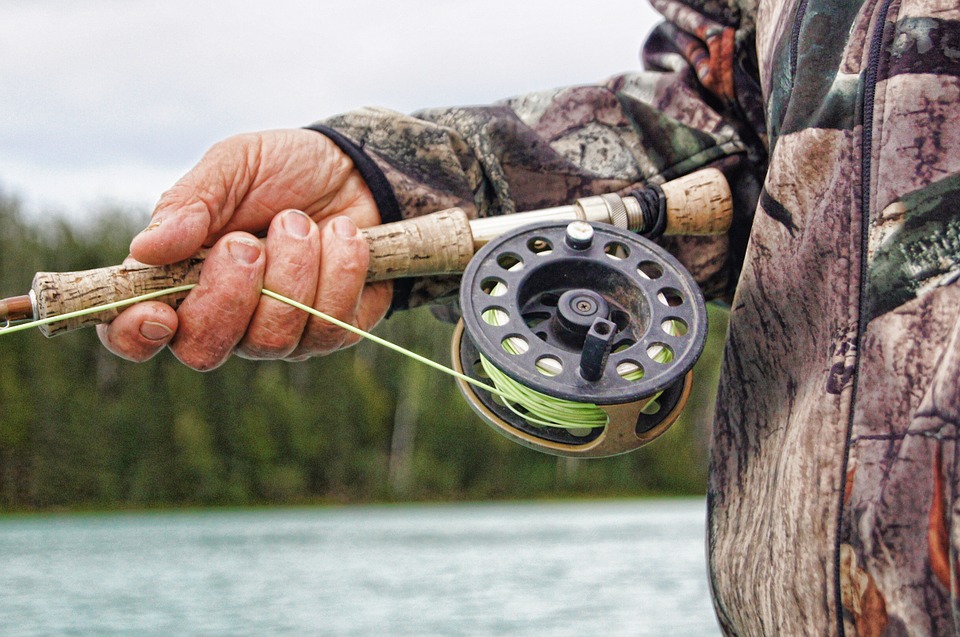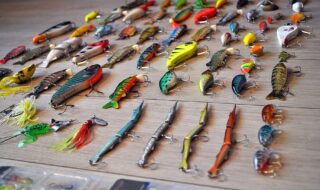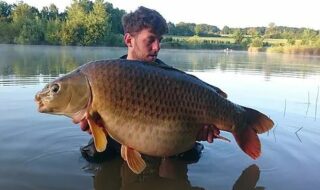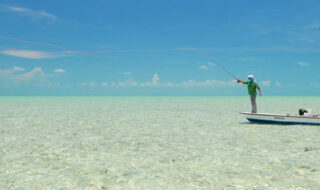Maybe you’re just beginning to fly fish or maybe you’ve never even heard of it, but either way by the end of this read, you will have a much better idea of what it is, what you need for it and how to do it.
What is fly fishing is a simple enough question so the answer doesn’t have to be complicated. The best way to understand it is to compare it to the traditional type of fishing because part of the difference lies in the two different techniques. We’ll get to that shortly, but it might help to clarify some misconceptions about fly fishing, first.
Misconception 1: Fly fishing is difficult. It’s a sport that is an art as much as it is a skill. It’s been described by the pros as the easiest way to teach a child how to fish, so that should debunk that myth
Misconception 2: It’s too expensive. This might mean that you’ve been shopping in the wrong places, and reading the wrong stuff. You can start fly fishing with minimal investment.
Misconception 3: Fly fishing is just for trout. The truth is, if it swims it can be caught on a fly rod.
These are just some myths ‘flying’ around that you shouldn’t pay attention to. Now, we can get back to our main topic.
Fly fishing is all about a technique used in fishing where the bait, that resembles a fly, is used to lure fish from the water. The idea is to make the bait seem like an insect of sort on top of the water’s surface or slightly below it. This attracts the fish more than the usual habitants around them in the water. So, you’re presenting an artificial lure to a fish that is typically an imitation of any sort of insect, and your mission is to outsmart the fish. If you know about some basic fishing, you would know that this technique is in stark contrast to traditional fishing where the bait is cast out to the fish under the water.
Comparing the set up or method between both types of fishing will give you a clearer picture.
Traditional fishing set up
With traditional fishing methods, a cast is made using some sort of bait which is attached to the end of the line. It will be noticeable to you that the line is very thin and lightweight material where the bait or lure is the heaviest part. When you cast, it’s your bait that carries the momentum through the air, with the lightweight line trailing behind. The bait on the hook and attached weights allow you to make a cast that gets good distance. That the weight of the lure is what is necessary for fishing. If all goes according to plan, the fish smells or sees the bait, bites, gets caught on the hook and you’ve caught your fish!
Fly fishing set up
Fly fishing is different. The fly has no or little weight itself, and delivering the fly onto the water has to be very subtle to avoid scaring the fish away. So the main difference in casting a fly is that the artificial flies used to catch fish weighs very little. The reason for the fly being this light is that it’s supposed to represent something small and lightweight, like an insect. To make up for this difference in weight, a combination of casting techniques and the correct fly line is the key to go about getting the fly out far enough to where the fish are.
To know more about this type of fishing, we’re going to talk about a few different factors
The rod: The fly rod makes casting a fly line possible. It’s actually the line that makes the cast happen, but the rod makes the job of moving the line back and forth easier. Typically, a rod is longer than regular fishing poles. An average fly rod is about 9 feet long. This length fits most of the needs from beginners to advanced fly fishers. Below or higher than 9 feet would be considered a specialty rod.
The weight of the rod is also important because the rods are made to balance with a specific fly line. When a fly rod is rated as a 6 weight rod, this means that it is made to be used with a 6 weight fly line. A 9 weight rod takes a 9 weight line, and so on. We’ll get into more details about the line, further down. The average fisher will probably start with either a 4, 5 or 6 weight. Anything less than a 4 would be for a special need, and the same applies to anything above a 6 weight.
Fly reel: Regular fishing rods often have a closed faced reel, while fly fishing reels are open and of the centrepin type. This means your hand position will be in the front of the reel, in contrast to regular poles where the main hold is behind the reel. The main key in choosing a fly reel is to pick one that can hold the necessary amount of backing and fly line for the weight of the rod that you are fishing with. So if you’ve bought a 5 weight fly rod, make sure you are choosing a fly reel that will accommodate fly line weights from 4 to 6.
Fly lines: For great catches, you need to know how to choose a fly line, which is at the core of everything, so far. The fly fishing line has a few basic parts. In order to properly set up your reel, you will need to know the order to piece everything together. Here, we’re talking about backing, line, leader, and tippet.
Backing: The first thing to go on your reel is the backing; backing is essentially a type of string that is braided and retains its strength when it’s wet. One of its purposes is to fill up space on the reel, so that every time you crank in the reel, you bring in more line.
Line: You first want to know if the line floats or not because there are lines that sink. Our advice is that if you’re going to have a wide-ranging of fly fishing experiences such as fish streams, big rivers, lakes, and ponds, consider buying a weight-forward floating fly line. As the name implies, more of the line’s weight is placed at the forward on the line which makes it easier to make a short cast, which is how most beginners begin. The weight forward has a few advantages:
- It makes the job easier if casting for distance
- Has better casting abilities when the weather is windy
- Better designed to cast large, air resistant flies
In fly fishing, the line itself provides the weight that will make the rod bend. The fly line is designed to have the weight and provides the weight needed to make distance casts. If it’s one weight, that is going to be your thinnest, while15 or 16 will be your thickest line.
Leader: The leader is the connection between your fly line and your fly. The leader equals a tapered butt section, plus tippets. The leader has to be tapered because that’s where it’s going to attach to the fly line. A general rule of thumb is to keep the leader the same length as the fly rod.
Tippets: Tippets come marked as 1x, 2x, 3x and so forth, and they rebuild the leader line. When purchasing, keep in mind that the higher the number, the thinner the diameter of the tippet, and likewise the lower the number, the thicker. Determining the size you buy will depend on the size, weight and wind resistance of the fly you’re casting. It could also depend on the type of fish; big fish will probably need thicker tippet. Most importantly, the tippet must match the size of the fly. If, for example, the fly is a size 12, divide 12 by 3 or 4. This will tell you that you need a 3x or 4x tippet. The reason you’re dividing by either of the two numbers is that a fly could be a size 12, but differs in weight. If the diameter of the tippet isn’t suitable for the fly, your cast will collapse.
Flies: Flies can be so light that they float and can look like an insect suspended on the water surface. They can also sink and be made to look and swim like fish and even sink to the bottom and mimic a crab or a crayfish. There are 2 categories of flies; floating and sinking. The dry ones float on the surface of the water to imitate an insect. These will typically represent nymphs. Streamers are intended to mimic small fish or aquatic life, like leeches. The type of fly to use is based on the water conditions, location and type of fish you are trying to catch. When fly fishing in saltwater, for instance, it hardly makes sense to imitate flying insects since most of the food in the ocean is swimming underwater. So here we imitate fish, shrimps, crabs and many other animals.
By now, you should be starting to have a clearer picture and an idea of the type of gear you’ll be needing. If you’re a total beginner or never had the pleasure of owning your own gear and can’t wait to start, then purchasing fly fishing kits for sale is a great and affordable way to begin. Starter kits provide you with a fly fishing rod and reel, and the line may already be spooled, making your beginning trials at fly fishing easier than you thought
Main accessories: Fly fishing is a gadget-oriented sport, but don’t get carried away by all the gadgets since you only need a few. Some of the main accessories used are:
- Line clippers, or nippers: They should be on the top of your list to snip lines or other small items.
- A pair of forceps: They will also be on the list since they’re helpful to hold things, especially small things or pulling the fly out of the fish’s mouth after being caught.
- Floatant: That’s a liquid or powder that helps keep your dry fly above water longer. Gink was the first to come out decades ago, but there are several varieties on the market to suit your fishing style. Casting: There are many different casting strategies, but all of them involve whipping the fly road back behind you, and then back out. It’s about keeping the rod as straight as possible so you need to keep your wrist stiff. The casting is done with a series of upside-down pendulum-like motions where the rod is tipped back and forth while the fly line follows its tip. By repeating the motion, the fly-angler can give the line enough forward speed and length to stretch and deliver the fly where the fish is. If all is done correctly, the fish will not notice the fly line, leader or tippet, and take the bait.
The water
The most obvious places to start looking for trout in moving water are areas where there is a current change. These are places where trout can sit in slower water, yet has close access to faster water. They can dart out, grab a bite to eat, and return to their holding spot. In fly fishing, you will usually find yourself in the middle of a whooshing creek or stream, or by a river casting many times over, trying to figure out where the fish are hiding.
Enjoy the experience
There’s more to it than this when it comes to technique, but fly fishing is so much more about the exciting experience. With traditional fishing, you’ll probably sit on the banks of the water or in a boat, and wait for the fish to bite. While there’s a mood for this and a mood for that, there are a challenge and fun in fly fishing taking you in a moving river, which are favorite spots for this sport. Fly fishing is a different style than regular fishing and is more active. It can take you to some of the most beautiful scenic locations you’ll ever see. You can be right in the middle of it all, challenging the fish in a beautiful outdoor environment.
MORE: SEE https://www.total-fishing.com/category/features/fly-fishing-features/






